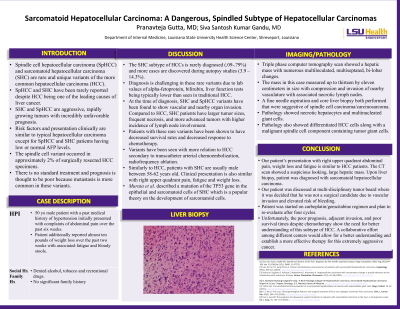Back


Poster Session E - Tuesday Afternoon
Category: Liver
E0571 - Sarcomatoid Hepatocellular Carcinoma: A Dangerous, Spindled Subtype of Hepatocellular Carcinoma
Tuesday, October 25, 2022
3:00 PM – 5:00 PM ET
Location: Crown Ballroom

Has Audio

Pranavteja Gutta, MD
Ochsner LSU Health Shreveport
Shreveport, LA
Presenting Author(s)
Pranavteja Gutta, MD, Siva Santosh Kumar Gandu, MD
Ochsner LSU Health Shreveport, Shreveport, LA
Introduction: Spindle cell hepatocellular carcinoma (SpHCC) and sarcomatoid hepatocellular carcinoma (SHC) are rare and unique variants of the more common hepatocellular carcinoma (HCC). SpHCC and SHC rarely have been reported despite HCC being a leading cause of liver cancer. SHC is an aggressive, rapidly growing tumor with a highly unfavorable prognosis.
Case Description/Methods: A 50-year-old male with a past medical history of hypertension presented to the emergency department complaining of abdominal pain and nausea that started six weeks prior to admission. The patient additionally reported approximately ten pounds of weight loss over the past two weeks. A triple phase computer tomography scan showed a hepatic mass with numerous multiloculated, multiseptated, bi-lobar measuring up to 13 x 11 centimeters in size with compression/invasion of vasculature and necrotic lymph nodes. A fine needle aspiration and core liver biopsy was performed that showed pathology suggestive of spindle cell carcinoma/carcinosarcoma (figure 1). The patient’s case was discussed at tumor board where it was decided he was not a surgical candidate due to the elevated risk of bleeding. Carboplatin/gemcitabine regimen started with re-staging planned.
Discussion: The SHC subtype of HCCs is rarely diagnosed (.79%) but most cases are found on autopsy studies (14.3%). The challenge in diagnosing these rare subtypes of HCC arises due to lab values of alpha-fetoprotein, bilirubin, and liver function tests being lower than seen in traditional HCC. As seen in our case study, at the time of diagnosis of SHC and SpHCC many of the cancers are found to have vascular invasion and invasion of nearby organs. When compared to HCC, SHC patients have larger tumors, frequent necrosis, invasion of adjacent organs, and more advanced tumors with higher incidence of lymph node involvement. Treatment modalities have not been established and no consensus has been formed about SHC. Patients with this aggressive subtype of HCC have lower survival rates and lower response to chemotherapy. Some studies have shown that SHC has the lowest survival rate among all subtypes of HCC with median survival of four to eight months. Unfortunately, the poor prognosis, adjacent invasion, and poor survival times despite chemotherapy show the need for better understanding of this subtype of HCC. A collaborative effort among different centers would allow for a better understanding and establish a more effective therapy for this extremely aggressive cancer.

Disclosures:
Pranavteja Gutta, MD, Siva Santosh Kumar Gandu, MD. E0571 - Sarcomatoid Hepatocellular Carcinoma: A Dangerous, Spindled Subtype of Hepatocellular Carcinoma, ACG 2022 Annual Scientific Meeting Abstracts. Charlotte, NC: American College of Gastroenterology.
Ochsner LSU Health Shreveport, Shreveport, LA
Introduction: Spindle cell hepatocellular carcinoma (SpHCC) and sarcomatoid hepatocellular carcinoma (SHC) are rare and unique variants of the more common hepatocellular carcinoma (HCC). SpHCC and SHC rarely have been reported despite HCC being a leading cause of liver cancer. SHC is an aggressive, rapidly growing tumor with a highly unfavorable prognosis.
Case Description/Methods: A 50-year-old male with a past medical history of hypertension presented to the emergency department complaining of abdominal pain and nausea that started six weeks prior to admission. The patient additionally reported approximately ten pounds of weight loss over the past two weeks. A triple phase computer tomography scan showed a hepatic mass with numerous multiloculated, multiseptated, bi-lobar measuring up to 13 x 11 centimeters in size with compression/invasion of vasculature and necrotic lymph nodes. A fine needle aspiration and core liver biopsy was performed that showed pathology suggestive of spindle cell carcinoma/carcinosarcoma (figure 1). The patient’s case was discussed at tumor board where it was decided he was not a surgical candidate due to the elevated risk of bleeding. Carboplatin/gemcitabine regimen started with re-staging planned.
Discussion: The SHC subtype of HCCs is rarely diagnosed (.79%) but most cases are found on autopsy studies (14.3%). The challenge in diagnosing these rare subtypes of HCC arises due to lab values of alpha-fetoprotein, bilirubin, and liver function tests being lower than seen in traditional HCC. As seen in our case study, at the time of diagnosis of SHC and SpHCC many of the cancers are found to have vascular invasion and invasion of nearby organs. When compared to HCC, SHC patients have larger tumors, frequent necrosis, invasion of adjacent organs, and more advanced tumors with higher incidence of lymph node involvement. Treatment modalities have not been established and no consensus has been formed about SHC. Patients with this aggressive subtype of HCC have lower survival rates and lower response to chemotherapy. Some studies have shown that SHC has the lowest survival rate among all subtypes of HCC with median survival of four to eight months. Unfortunately, the poor prognosis, adjacent invasion, and poor survival times despite chemotherapy show the need for better understanding of this subtype of HCC. A collaborative effort among different centers would allow for a better understanding and establish a more effective therapy for this extremely aggressive cancer.

Figure: Patient's pathology showing spindle cells.
Disclosures:
Pranavteja Gutta indicated no relevant financial relationships.
Siva Santosh Kumar Gandu indicated no relevant financial relationships.
Pranavteja Gutta, MD, Siva Santosh Kumar Gandu, MD. E0571 - Sarcomatoid Hepatocellular Carcinoma: A Dangerous, Spindled Subtype of Hepatocellular Carcinoma, ACG 2022 Annual Scientific Meeting Abstracts. Charlotte, NC: American College of Gastroenterology.
